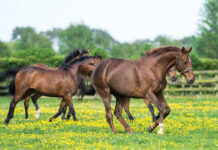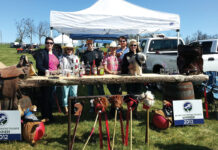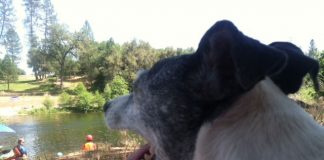Read about Rose Caslar’s dressage sabbatical.
Rose Caslar, an experienced rider and trainer, arrives for her year-long internship at American classical dressage master Paul Belasik’s Pennsylvania Riding Academy to find she must put aside everything she knows about riding, from her position to dressage theory. Rose is courageous, honest and remarkably open, sweeping readers along in the daily work, her adventures, and her private thoughts. The tremendous workload of a first-class training facility is not for the faint of heart; neither are weekly lessons with sometimes mysterious Belasik who encourages Rose to ask the right questions, giving nothing away.
Forget Everything You Thought You Knew
I have now been at Lost Hollow Farm, home of the Pennsylvania Riding Academy, working with Paul and Andrea, for one month. I have not written until now because frankly, I have been A) exhausted, B) occasionally confused, and C) rather unsure just how to describe the experience. Lest that all sound terribly negative and discouraging, let me explain.
My artist stepfather conducts woodcarving classes in which students carve an entire full-size carousel animal in four to five days. Or rather, he lets them chip away at it for a while and then periodically steps in to create a hurricane of woodchips, lending the student some progress. In the first part of the workshop, he says it is totally imperative to create, as he calls it, “atmospheric distortion.” This means to confuse, enlighten, befuddle, and simply bowl over a student’s normal way of looking at art and their own abilities in order to create a new mental and physical space for learning.
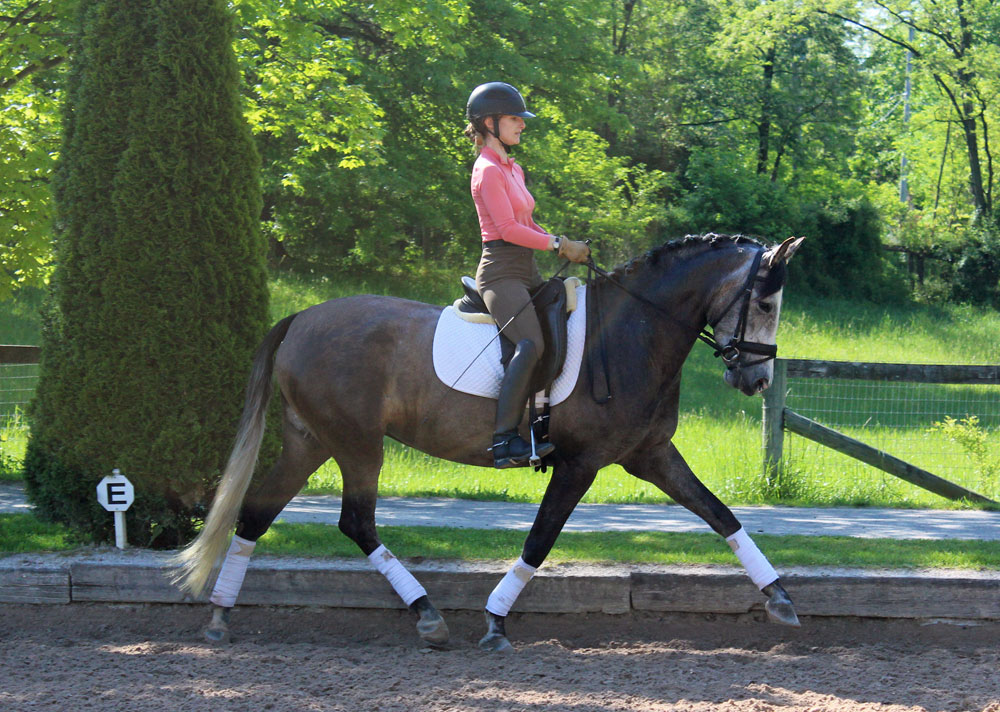
In a way, this is what the interns’ workload at the Academy does. Like an artist opening your mind or a boot camp breaking you down to build you up, you must learn do more than you thought you could and to do it differently. My bodyworker Laurel Sanders says wisely, “Your old ways aren’t working anymore.”
This year, those interns are the excellent Ryan Hopkins and me. At the barn we start early, we end late, and there isn’t any stopping in between. Unlike my other working student and intern experiences at smaller barns with fewer horses, the work-to-riding ratio is about 10:1. Keeping around 28 horses, including horses in training, young horses from weanlings to 2-year-olds, broodmares, and a stallion, with a very high standard of care, attention, and grooming is simply a great deal of work!
A pleasant side effect to this is learning more about successful barn management than I have ever known before. Riding one hour per day out of 11 means that not a minute in the saddle can be wasted. It means that no matter how tired I am, I owe it to myself and the loving man I left in Oregon to make every minute count. Thus, various titles I have thought of for this entry are as follows: Dressage Boot Camp, 30 Days to Ripped (my biceps are looking nice, thank you!), and Breaking Up is Hard to Do: Forget Everything You Thought You Knew.
Just Another Day
To give you a sense of a typical day at the barn, here is a quick overview of our day as interns at the Academy. Ryan and I arrive at 7 a.m., check the turnout and training schedule, feed the horses in the barn, then begin bringing in and feeding the horses from the paddocks and turning out the horses in the barn.
We start cleaning and bedding the 15 stalls and scrubbing and refilling water buckets, pausing near 8 a.m. to get the first set of horses ready to be ridden. This may include full baths for those horses that love to get themselves as dirty as possible overnight. The standard of grooming, according to my training by previous intern Coral and overseen by Andrea, is: “Every horse that walks out of this barn needs to be show ready.”
After Paul and Andrea take their first set of horses down to the arena to school, Ryan and I continue to clean the barn, pausing about every 45 minutes to get another set of horses ready, meanwhile switching the horses in turnout, starting the day’s many loads of saddle pads and polo wraps laundry, and trying to clean a few bridles as we go. Around 11 a.m., however the schedule is written, either Ryan or I will go down to the arena with our own horse to school.
Then we continue taking in hot horses that have just been worked and making sure the next set to train is ready. At some point, whichever intern didn’t ride in the morning takes his or her horse down to school in the afternoon. If a client is coming for a lesson, we have the school horse prepared.
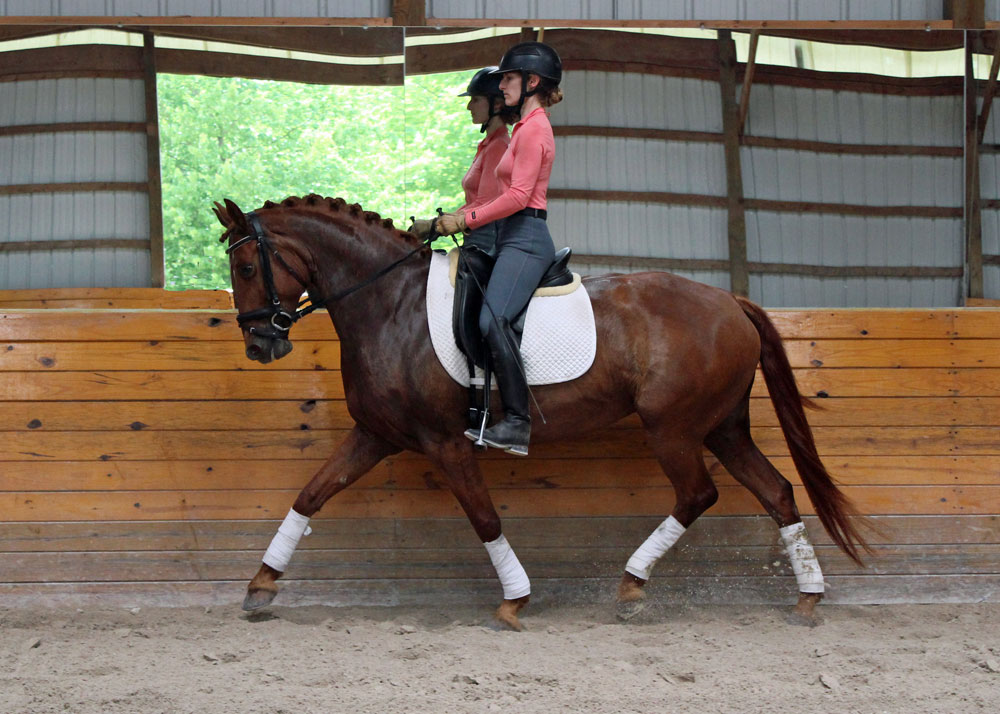
We make up the afternoon feed buckets and then begin afternoon chores, picking stalls, refilling waters, putting horses out, bringing horses in, cleaning tack, making up the morning feed, picking the outside paddocks, doing any outside chores such as scrubbing and refilling water tanks or hay huts, then finish the laundry, sweep the barn, and mop the tack room.
On Thursdays, we dust the entire barn. If it is a slower day, for instance because Paul is away teaching a clinic, we may try catch up on other more intermittent chores, like fixing fences, clipping horses, pulling manes, or raking up the hay loft. Altogether, it is a very well-run barn, to which the shining health of the horses is a testament.
And that is why for the first two weeks, it was all I could do to stay up until 8 p.m. I experimented with triple insoles in my boots to soothe my aching feet. I discovered that Epsom salts in a hot bath really do work to relieve muscle soreness, and that I really must pack three times the amount of food I would typically eat in my lunch bag because the hard work makes me ravenous.
After a month, I have found myself caring even more and more about the work … paying attention to detail and seeing that excellence starts with high standards in the lowliest tasks.
But after a month, I have found myself caring even more and more about the work … paying attention to detail and seeing that excellence starts with high standards in the lowliest tasks. Paul says, rightly, that improving in dressage is about Showing Up and Doing the Work. Neither horse nor rider will improve if effort is not made. Pretty simple, right?
But it so easy for riding and training to slip or be nudged aside. In my own life this past year, my riding and fitness took a back seat to full-time computer work and household responsibilities. Working at the barn can feel like a daily marathon of tasks, but it is a daily practice in showing up and doing the work. How many years did the Zen students spend sweeping the floor and hauling water? No one really knows, but it was a lot.
Trust the Teacher
This brings us to another important aspect of the internship experience and another thing Zen students had to do; trust the teacher. In his book Complete Training of the Horse and Rider, Alois Podhajsky outlines the basic requirements for a student entering a manège, urging the student to trust the teacher and trust the system to provide what is needed and lead where one must be led. It goes without saying then that it is necessary to leave one’s ego at the farm gate each morning.
Paul teaches classical dressage that can be most closely compared to the Austro-Hungarian method of the Spanish Riding School in Vienna. The historical SRS has its roots deep in classical dressage with a lineage dating to Giovanni Battista Pignatelli’s 16th century riding school in Italy, where European noblemen went to study during the Renaissance. These men created a diaspora of dressage, some of which changed over time as countries such as France, Germany and Spain added their own national colors.
To Paul, national tendencies aside, if dressage isn’t about the goal of shifting weight and carrying capacity to the hind end to ultimately achieve the highest collection (such as levade), it isn’t classical dressage. And now, dear reader, here is where my own atmospheric distortion comes in; it seems I am hearing a new language. Paul uses phrases I have never heard before, such as “weaving the neck into the back,” and “connecting the rein to the hock.”
All artists and writers try to go on a sabbatical, a time away from all the usual household and relationship responsibilities to devote purely to their practice.
My family loves to tease me about how I have quit a good job, left my long-suffering sweetheart and all things beloved to clean more stalls than we have in our entire county in rural Oregon and wade knee deep through horse laundry, all of which is white. My family has been relentless in their joshing, but in a recent phone call my mother took a slightly different tack.
She said, “You know, honey, this is a really special opportunity for you. All artists and writers try to go on a sabbatical, a time away from all the usual household and relationship responsibilities to devote purely to their practice.”
I could hardly believe my ears. This generous remark came from the woman whom I know has been struggling not to roll her eyes for the entire year leading up to me putting my horses in my 1970 Trail Magic horse trailer and driving alone across the country to some place I didn’t know a whole lot about. But I liked my mother’s idea. So, Paul may call it an internship, but for me this is a sabbatical … the gift of an entire year to study dressage with a master classical rider and trainer with the good wishes (mostly) of my loved ones.
We begin at the beginning, with the rider’s position.
Text excerpted with permission from Dressage Sabbatical: A Year of Classical Riding at Lost Hollow Farm. To read the captivating tale of a rider’s challenge of a lifetime in its entirety, order your copy at www.kipmistral.com/shop.
This article originally about Rose’s dressage sabbatical appeared in the April 2018 issue of Horse Illustrated magazine. Click here to subscribe!


